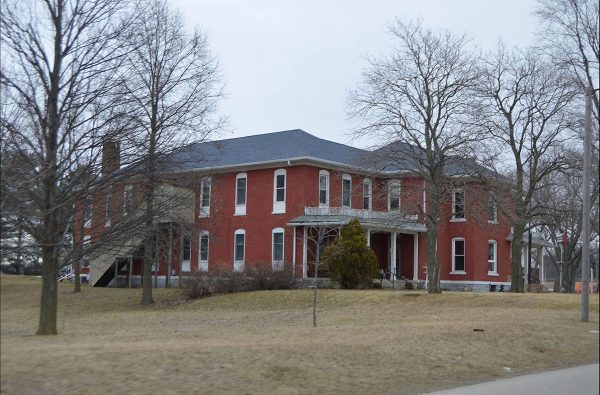For information on the source (the book Counties of White and Pulaski, Indiana, published by A.F. Battey & Co., Chicago, in 1883), see this post.
 Photo of Pleasant View, the former Pulaski County Home. This is a view of the western side and front. The original section was built in 1881 and was expanded with two wings in 1897. It is a large, four-story, Italianate style red brick building. It has a low-pitched, multiple hip and valley roof and features multiple porches, stoops, and access points. Also on the property are the contributing Pest House (1882), post and beam barn (1929), and milk house. It is one of Indiana’s few county homes that was still in active service when it was listed on the National Register of Historic Places in 2015.
Photo of Pleasant View, the former Pulaski County Home. This is a view of the western side and front. The original section was built in 1881 and was expanded with two wings in 1897. It is a large, four-story, Italianate style red brick building. It has a low-pitched, multiple hip and valley roof and features multiple porches, stoops, and access points. Also on the property are the contributing Pest House (1882), post and beam barn (1929), and milk house. It is one of Indiana’s few county homes that was still in active service when it was listed on the National Register of Historic Places in 2015.
Treatment And Care For County Poor
The old way of taking care of the indigent and helpless was to appoint Overseers of the Poor in each township, who were required to provide for the paupers at the expense of such townships. The care of the poor was sold to the lowest bidder.
Sometimes great hardships were thus wrought upon the helpless, as they often fell into the tender mercies of heartless persons, who endeavored to make money out of the bargain, and this generally could only be done by neglecting, half-clothing and half-starving the unfortunates.
After many years, the system was so far changed that the county, instead of the townships, bore the expense and assumed the responsibility, though still the care of the paupers was sold to the lowest bidder.
Finally a “county physician” was employed at so much by the year to furnish the poor with the necessary medical attendance. The following is taken from an early record: This is to certify that the undersigned Overseer of the Poor of the Township of Monroe, sold at private sale a certain pauper by the name of [name not given], of said township, to Jesse Klinger, for the sum of $5 per week, this 14th day of October, 1839. Given under my hand, etc. Oliver B. Haydex. This pauper was doctored by John M. Oowan and Hugh Carroll.
In 1843, a certain Dr. W. Hambel Salter presented a bill of $188.79 to the Commissioners for medical attendance upon one of the county paupers. The bill was duly considered and the amount cut down to $50, which sum was paid the doctor in full for his services.
The poor expense for the fiscal year ending May 31, 1851, was $762.56; but for the following year it was only $585.80.
At last, in March, 1865, the present poor farm was purchased of James Boyles for $6,000, a portion of which amount went to pay off certain mortgages against the property. The farm at that time consisted of 165 acres, on the southwest quarter and the north part of the southeast quarter of Section 14, Township 30 north. Range 2 west.
Joel Whipple became the first Superintendent of the Poor Farm. Here the county paupers (some ten or twelve in number) were removed. At this time there was upon the farm only an ordinary farmhouse, but some additions were made until the few inmates were comfortable.
Mr. Whipple remained Superintendent until the spring of 1869, when he was succeeded by Joseph K. Boyles, who remained until 1875, his successor being Elias Pattison. In 1875, an addition was built to the poor house by Peter J. Eldridge, at a cost of $538. Mr. Boyles again became Superintendent in 1877.
In 1881, the two-storied brick poor house was built at a cost of $3,300. This building and the farm upon which it rests are a credit to the humanity of Pulaski County. Joseph Shields is the present Superintendent, and has the care of some thirteen inmates.